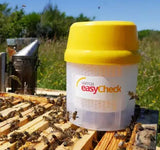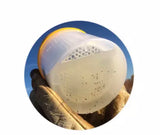Varroa Easy Check Monitoring Tool
Alcohol wash, sugar roll, CO2 injection… These 3 methods are now available in the same tool. It’s up to you to choose the method that suits you best!
Monitoring: An important practice that could save your colonies
The main objective is to avoid a critical level of varroa mite infestation that could lead to colony losses. Varroa monitoring is used to estimate the degree of varroa infestation, optimize the time of treatment, and confirm that treatment was successful.
Monitoring also makes it possible to choose the most efficient control product, determine if treatment is needed soon, or if you can wait until later in the year. Knowing your hives’ varroa levels in the late summer and fall will aid in making treatment decisions at that time, and help ensure that your colonies do not enter the winter with high mite loads. This will help reduce winter colony losses and give you stronger spring colonies. The cost of replacing a colony of honey bees, feeding the new hive, and lost honey production is a good argument in favor of regular monitoring
How often should monitoring be performed?
“Accurately assessing and understanding mite population is the basis of an Integrated Pest Management (IPM) control strategy. Waiting too long to confirm elevated mite population numbers is risky. A delay in treatment can reduce a colony’s likelihood of survival over the winter and contribute to spreading mites to other colonies.”
How often should monitoring be performed?
“Accurately assessing and understanding mite population is the basis of an Integrated Pest Management (IPM) control strategy. Waiting too long to confirm elevated mite population numbers is risky. A delay in treatment can reduce a colony’s likelihood of survival over the winter and contribute to spreading mites to other colonies.”
Monitoring should take place at least three times a year, and ideally four times:
1
Early spring
Early detection makes it possible to plan effectively and assess the need for an early springtime treatment without honey supers. A second check will be necessary after the spring treatment to confirm its efficacy.
3
Before your main treatment
(usually late July – August)
Choose the best-suited late-season treatment
depending on the level of infestation. Knowing your mite infestation before treatment is very important as it will help you assess is efficacy.
2
During a honey flow
Detect a massive varroa build-up
and plan possible intermittent treatment between honey flows.
4
After your treatment
Ensure the effectiveness of late summer treatment and assess the need for additional treatment in winter (when brood is absent) or early next spring.






